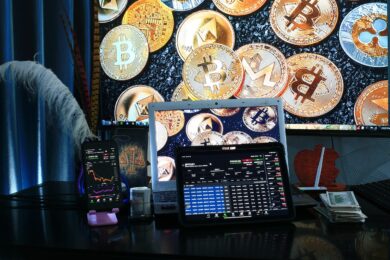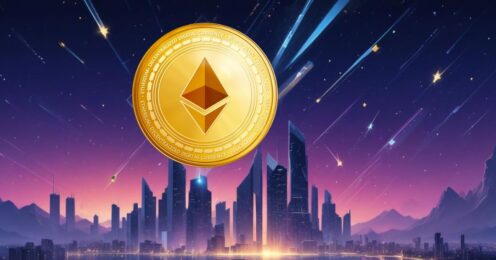
Is the Fed finally pausing interest rate hikes? Stocks hit 9-month highs
- The market is forecasting a pause in rate hikes for the first time in 14 months at this month’s Fed meeting
- Markets have hit nine-month highs off back of this forecast and the debt ceiling resolution
- However, lagged effects of monetary tightening remains to be seen, writes our Head of Research, Dan Ashmore
US stocks have hit a nine-month high, the S&P 500 adding 1% Thursday to close at its highest level since August 2022. The tech-heavy Nasdaq Composite also banked a nine-month high, increasing 1.3%.
The boost came by virtue of the long-awaited resolution to the political game that was the US debt ceiling negotiations. Democrats and Republicans finally put pen to paper and wiped out what was always an extremely remote chance of a sovereign default.
And so, with that circus out of the way, financial markets can go back to focusing on what actually matters: the possibility of recession and the overall health of the economy. Of course, this all feeds into the Federal Reserve and its all-important interest rate policy.
Are interest rate hikes over?
Copy link to sectionSo, where are we now? We are over a year into one of the fastest hiking cycles in recent memory, rates now north of 5%. Following over a decade of ultra-low rates, that represents an enormous departure from what was deemed the “new norm”.
The Fed funds rate is the single most important lever in the economy. It feeds through to all forms of debt, and quite literally sets the price of money in the economy. With levered individuals and companies suddenly forced to refinance at 5% rather than 0.5%, this is meant to spell doom.
Things are meant to break when this occurs. And, some things have. Silicon Valley Bank (SVB) waved goodbye in March, the banking contagion soon spreading to Europe. But despite further crises at banks such as First Republic, the chaos seems to have been contained to regional banks (aside from a certain Swiss bank), and despite this being a large problem for a variety of reasons, it doesn’t seem a systemic threat ,nor a source of panic for the financial system at large.
Indeed, if anything, the economy remains too hot, refusing to take the foot off the pedal. Employment remains very tight, and while sentiment has dipped across the market, underlying economic data does still appear relatively resistant.
So, where does this leave us? Are we in a situation where interest rates need to stay higher for longer? Unfortunately for tech bros, crypto lovers and well, may other people, that may be the result. But rather than listen to me speculate blindly about what the Fed will do (as if anyone has been able to pull that off thus far), let us take a look at what the probabilities are saying when we back them out from Fed futures.
The next Fed meeting is on June 14th. While some would have hoped that we would be in cutting territory by now, there is a 0% chance assigned to that – in fact, there is even a 28.5% chance expectation that we will see another hike in two weeks. This contrasts to the same forecasts a month ago (the pie chart on the right), when there was a 16.6% chance of a 25 bps cut, and a perceived zero chance of another hike.
Fed is between a rock and a hard place
Copy link to sectionThe shift in probabilities highlights what we mentioned above: whisper it quietly, but the market is actually doing quite well. The only thing is, in this muddled, high-inflation world we live in, that is not always a good thing. The Fed is stuck between a rock and a hard place because, in order to continue to wage the fight against inflation, it is meant to suck liquidity out of the system so that the economy slows down and that inflation ticks down to normal.
The issue is that high interest rates are prohibitive for the economy – with the price of credit so steep, things break down as discussed earlier. Higher for longer means more pain, and the potential for a worse recession. This sums up the Fed’s predicament: hike rates enough to pull inflation in, but not so much that an aggressive recession is triggered. And hikes are already really, really high compared to the what was believed to be “equilibrium”.
Let us look at inflation. It currently sits at 4.9%. That is in a different stratosphere compared to the Fed’s 2% target. Then again, it has fallen nine months in a row, after it came close to pushing double digits last summer. The next reading arrives June 13th.
With inflation coming down but remaining high, it opens up the discussion, and there are those on both sides of the fence. Earlier this week, Loretta Mester, president of the Cleveland Fed, pushed back against the consensus forecast of a pause in interest rate hikes at the June meeting.
“I don’t really see a compelling reason to pause — meaning wait until you get more evidence to decide what to do. I would see more of a compelling case for (hiking) . . . and then holding for a while until you get less uncertain about where the economy is going.”
Loretta Mester, president of the Cleveland Fed
However, this contrasts with what Fed chair Jerome Powell indicated last month. He signalled that, for the first time in 14 months, a pause was very much in play.
“Having come this far, we can afford to look at the data and the evolving outlook and make careful assessments,” he said. He also acknowledged that the risks were growing as rates remain high, admitting that “the risks of doing too much versus doing too little are becoming more balanced.”
“As a result, our policy rate may not need to rise as much as it would have otherwise to achieve our goals,” he added.
What is clear is that this is the single biggest decision with regard to not only market prices, but the economy as a whole. History tells us that tightening cycles take their toll. Even with a pause this month, uncertainty remains high as to what effects still need to filter through. We spoke with Dr Craig Pirrong of the University of Houston on this last month, who warned that the Fed had bitten off more than it could chew, lamenting both the decisions that led to inflation in the first place, and also the actions since the hiking cycle began.
Even Jerome Powell himself acknowledges that “we face uncertainty about the lagged effects of our tightening so far.” That is what makes this analysis so challenging – that famous lag in monetary policy.
So while a pause may feel like a seminal moment in this cycle, even if it does come, there are more challenges ahead. But for now, all eyes turn to June 14th.
More industry news







